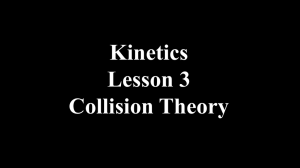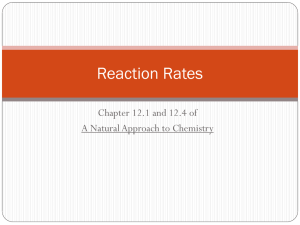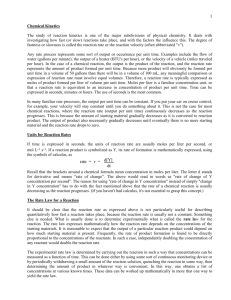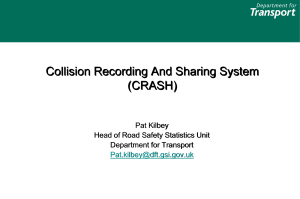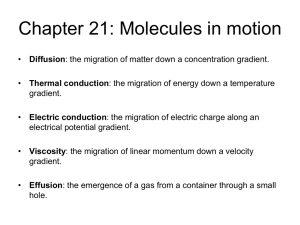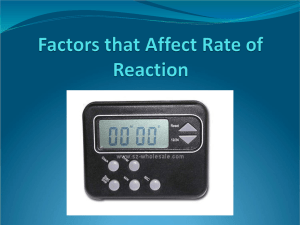Data, Observations, and Calculations
advertisement
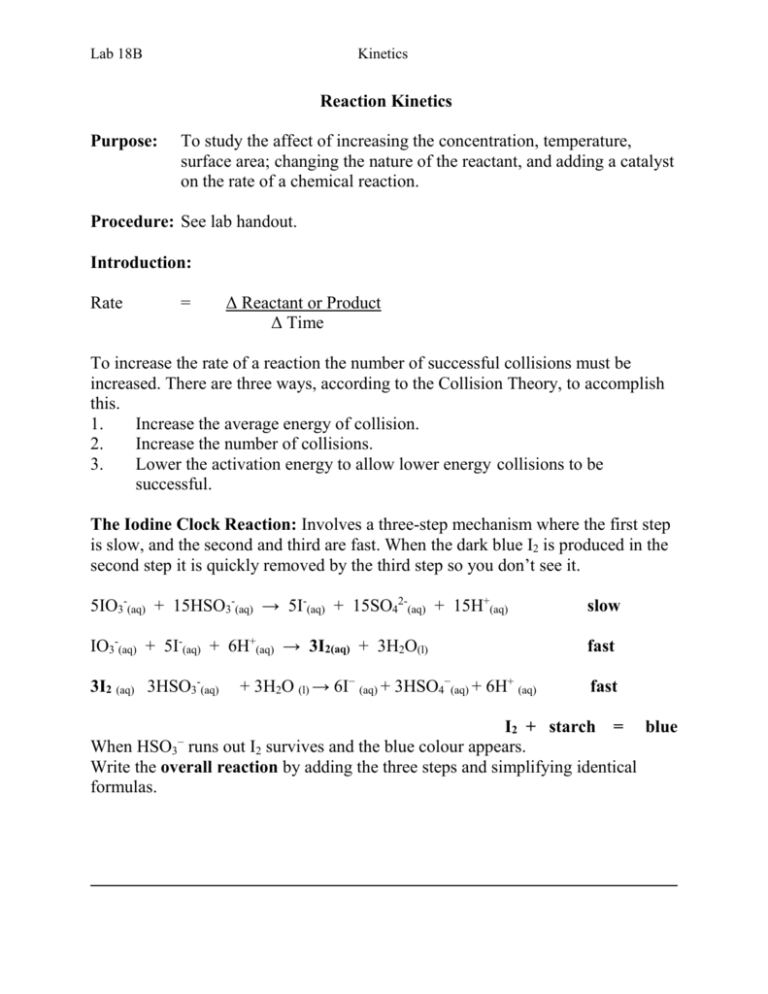
Lab 18B Kinetics Reaction Kinetics Purpose: To study the affect of increasing the concentration, temperature, surface area; changing the nature of the reactant, and adding a catalyst on the rate of a chemical reaction. Procedure: See lab handout. Introduction: Rate = Δ Reactant or Product Δ Time To increase the rate of a reaction the number of successful collisions must be increased. There are three ways, according to the Collision Theory, to accomplish this. 1. Increase the average energy of collision. 2. Increase the number of collisions. 3. Lower the activation energy to allow lower energy collisions to be successful. The Iodine Clock Reaction: Involves a three-step mechanism where the first step is slow, and the second and third are fast. When the dark blue I2 is produced in the second step it is quickly removed by the third step so you don’t see it. 5IO3-(aq) + 15HSO3-(aq) → 5I-(aq) + 15SO42-(aq) + 15H+(aq) slow IO3-(aq) + 5I-(aq) + 6H+(aq) → 3I2(aq) + 3H2O(l) fast 3I2 (aq) 3HSO3-(aq) + 3H2O (l) → 6I− (aq) + 3HSO4−(aq) + 6H+ (aq) fast I2 + starch = blue When HSO3− runs out I2 survives and the blue colour appears. Write the overall reaction by adding the three steps and simplifying identical formulas. Lab 18B Kinetics Data, Observations, and Calculations Part 1 Effect of Concentration In a graduated cylinder dilute the number of mL shown in the table of A to 10.0 mL by adding the required amount of water. Add this to 10.0 mL of undiluted B. Time the reaction from the time the solutions first mix to the first appearance of a blue color. Data Volume of A (0.020M KIO3) (mL) 10.0 9.0 7.0 5.0 3.0 Time for Reaction (s) 6.0 7.2 8.4 11.3 14.3 Moles of B (NaHSO3) Consumed Reaction Rate in (molesNaHSO3/s) Molarity of Solution A (KIO3) (M) 1. Calculate the moles of B (limiting reactant) consumed based on 10.0 mL of 0.0020M NaHSO3 being consumed in each trial. Put this value in the table. 2. Calculate the reaction rates in (moles NaHSO3/s) for each trial. Put these values in the table. 3. Calculate the molarity (M2) of solution A (KIO3) for each trial using M1V1 = M2V2 . M1 = 0.020M, V1 is in the table, and V2 = 20.0mL. Put these values in the table. 4. What is the relationship between concentration of reactant and rate? 5. Explain using the Collision Theory. Lab 18B Kinetics Part 2 Effect of Temperature In a graduated cylinder measure 10.0 mL of A. Measure 10.0 mL of B. Immerse each solution in a water-bath for five minutes to achieve a low temperature (ice). Record the exact temperature in the table. Mix A and B and time the reaction. Repeat at a higher temperature (room temperature). Record the exact temperature. Data Temperature (oC) 22 2 Time (s) 6.0 14 Moles of B Consumed (NaHSO3) Reaction Rate (moles NaHSO3/sec) 1. Calculate the moles of B (limiting reactant) consumed based on 10.0 mL of 0.0020M NaHSO3 being consumed in each trial. Put this value in the table. 2. Calculate the reaction rates in (moles NaHSO3/s) for each trial. Put these values in the table. 3. What is the relationship between temperature and rate? 4. Explain using the Collision Theory. Lab 18B Kinetics Part 3 Effect of the Nature of the Reactant- (wear goggles) 1. Add about 2 cm of 2 M HCl to a test tube. Add a piece of Zn. Write some observations. Write a balanced equation for the reaction. Observations Zn Bubbles produced very slowly Equation: 2. Add about 2 cm of 2 M HCl to a test tube. Add a piece of Mg. Test the gas produced with a lighter. Write some observations. Write a balanced equation for the reaction (wear goggles) Observations Mg Bubbles produced very fast Equation: 1. Which reaction is faster? 2. Which reaction has the higher activation energy: Mg or Zn? 3. Account for the difference in reaction rates using the collision theory. 4. What does the nature of the reactant mean? Lab 18B Kinetics Part 4 The Effect of a Catalyst 1. Add about 2 cm of 3 M H2O2 to two different test tubes. To one test tube add 10 drops of KI. After a few minutes, test the gas for the faster reaction with a glowing splint. Reaction: 2H2O2(aq) O2(g) + 2H2O(l) Observations H2O2 (no catalyst) Bubbles produced very slowly Observations H2O2 (catalyst) Bubbles produced very fast 1. Which reaction is faster? 2. Account for the difference in reaction rates using the collision theory. 3. Which reaction has more collisions? 4. Which reaction has more successful collisions? Lab 18B Kinetics Part 5 The Effect of Surface Area 1. Add about 2 cm of 2 M HCl to two different test tubes. To one test tube add a chunk of CaCO3 and to the other add about the same amount of powdered CaCO3. Reaction: CaCO3 + 2HCl(aq) CaCl2(aq) + CO2(g) + H2O(l) Observations (chunk of CaCO3) Bubbles produced slowly Observations (powdered CaCO3) Bubbles produced very fast 1. Which reaction is faster? 2. Account for the difference in reaction rates using the collision theory. 3. Which reaction has more collisions? 4. Which reaction has more successful collisions? Lab 18B Kinetics Conclusion State the results of this lab for the 4 parts by describing simple relationships between the two variables. Read over your purpose so that you understand what they are. Do not discuss the raw data or the procedure- focus on the relationship between the reaction rate and each of the 4 factors studied in this lab. Explain the results for the 4 parts in terms of the collision theory (you have already done this in your answers to the questions). Be brief and succinct. Use the terminology for the collision theory- look at your notes. Do not use pronouns- use the third person past tense. The length should be about half a page single-spaced and typed. Lab Report On the first page write the title, name, date, course and a purpose for this lab. The handouts will become the next four pages of the report. The conclusion is at the end of the report. Answer all of the questions in full sentences and in full detail using the terminology of the collision theory. I expect high quality work in grade 12. Do you want a good mark? Is your lab in order? Title, purpose, theory, data, questions, conclusion. Did you include all units in your calculations? Did you read over notes on the collision theory to insure your answers are correct? Have a friend read over your lab! Did you type and spell-check your conclusion? A Grade 12 conclusion should be very high quality. Consult your notes regarding the collision theory. Compare your answers to all lab questions. There is no excuse to lose marks here.



